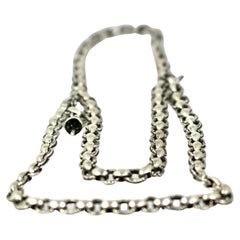Leonard Kamhout
Recent Sales
2010s American Modern Multi-Strand Necklaces
Silver
A Close Look at Modern Jewelry
Rooted in centuries of history of adornment dating back to the ancient world, modern jewelry reimagines traditional techniques, forms and materials for expressive new pieces. As opposed to contemporary jewelry, which responds to the moment in which it was created, modern jewelry often describes designs from the 20th to 21st centuries that reflect movements and trends in visual culture.
Modern jewelry emerged from the 19th-century shift away from jewelry indicating rank or social status. The Industrial Revolution allowed machine-made jewelry using electric gold plating, metal alloys and imitation stones, making beautiful jewelry widely accessible. Although mass production deemphasized the materials of the jewelry, the vision of the designer remained important, something that would be furthered in the 1960s with what’s known as the “critique of preciousness.”
A design fair called the “Exposition Internationale des Arts Décoratifs et Industriels Modernes” brought global attention to the Art Deco style in 1925 and gathered a mix of jewelry artists alongside master jewelers like Van Cleef & Arpels, Mauboussin and Boucheron. Art Deco designs from Cartier and Van Cleef & Arpels unconventionally mixed gemstones like placing rock crystals next to diamonds while borrowing motifs from eclectic sources including Asian lacquer and Persian carpets. Among Cartier’s foremost design preoccupations at the time were high-contrast color combinations and crisp, geometric forms and patterns. In the early 20th century, modernist jewelers like Margaret De Patta and artists such as Alexander Calder — who is better known for his kinetic sculptures than his provocative jewelry — explored sculptural metalwork in which geometric shapes and lines were preferred over elaborate ornamentation.
Many of the innovations in modern jewelry were propelled by women designers such as Wendy Ramshaw, who used paper to craft her accessories in the 1960s. During the 1970s, Elsa Peretti created day-to-night pieces for Tiffany & Co. while designers like Lea Stein experimented with layering plastic, a material that had been employed in jewelry since the mid-19th century and had expanded into Bakelite, acrylics and other unique materials.
Find a collection of modern watches, bracelets, engagement rings, necklaces, earrings and other jewelry on 1stDibs.
Finding the Right Multi-strand-necklaces for You
Vintage multistrand necklaces add glamour to any outfit and are easy to accessorize with.
One of the oldest known forms of jewelry is the necklace; evidence includes shell beads dating back at least 142,000 years. Multistrand necklaces appeared early in this history, with archaeologists identifying examples from ancient Mesopotamia.
One popular style of multistrand necklace is the torsade necklace, with “torsade” coming from the French word for twist or cable. These necklaces are made by twisting several strands of beads, pearls or other material together and securing them with a clasp. The hippie and counterculture movements of the 1960s saw costume-jewelry designers celebrating self-expression through colorful multistrand necklaces and no shortage of beads, while Ciner helped popularize the torsade necklace in the 1980s with strands of glass beads often held by animal-head clasps.
The bayadère necklace, also known as the rope necklace, is similar but has only a few strands of pearls or beads that are twisted or braided together. It was particularly popular at the turn of the 20th century, including as a gift for bridesmaids. Sometimes the beads or pearls match; other times, they are multicolored, with accents such as a single tassel or pendant. Another version is the choker-style dog-collar necklace, a multistrand necklace usually between 16 to 18 inches long.
In all of these variations, a multistrand necklace offers a touch of sophistication for your look, from everyday wear to the red carpet. Explore 1stDibs for multistrand necklaces in a range of lengths, styles and materials.
